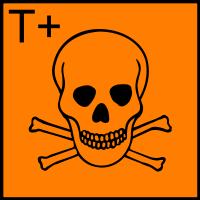|
Storage Condition
|
|
Room Temperature (15-30°C), Desiccate
|
 Show
data source Show
data source
|
|
|
Storage Warning
|
|
KEEP COLD, TOXIC, FLAMMABLE
|
 Show
data source Show
data source
|
|
Moisture Sensitive
|
 Show
data source Show
data source
|
|
|
European Hazard Symbols
|
 Flammable (F) Flammable (F)
|
 Show
data source Show
data source
|
 Nature polluting (N) Nature polluting (N)
|
 Show
data source Show
data source
|
 Toxic (T) Toxic (T)
|
 Show
data source Show
data source
|
 Highly toxic (T+) Highly toxic (T+)
|
 Show
data source Show
data source
|
|
|
UN Number
|
|
2929
|
 Show
data source Show
data source
|
|
3273
|
 Show
data source Show
data source
|
|
3384
|
 Show
data source Show
data source
|
|
UN3383
|
 Show
data source Show
data source
|
|
|
MSDS Link
|
|
|
German water hazard class
|
|
3
|
 Show
data source Show
data source
|
|
|
Hazard Class
|
|
3
|
 Show
data source Show
data source
|
|
6.1
|
 Show
data source Show
data source
|
|
|
Packing Group
|
|
1
|
 Show
data source Show
data source
|
|
I
|
 Show
data source Show
data source
|
|
II
|
 Show
data source Show
data source
|
|
|
Australian Hazchem
|
|
3WE
|
 Show
data source Show
data source
|
|
|
Risk Statements
|
|
11-26/27/28-29
|
 Show
data source Show
data source
|
|
11-26/27/28-29-50/53
|
 Show
data source Show
data source
|
|
R:11-14-22
|
 Show
data source Show
data source
|
|
R11 R26/27/28 R29
|
 Show
data source Show
data source
|
|
|
Safety Statements
|
|
16-28-36/37/39-45-60-61
|
 Show
data source Show
data source
|
|
16-36/37/39-45
|
 Show
data source Show
data source
|
|
S:8-9-16-29-30-45
|
 Show
data source Show
data source
|
|
S16 S36/37/39 S45
|
 Show
data source Show
data source
|
|
|
EU Classification
|
|
TF1
|
 Show
data source Show
data source
|
|
|
EU Hazard Identification Number
|
|
6.1A
|
 Show
data source Show
data source
|
|
|
Emergency Response Guidebook(ERG) Number
|
|
131
|
 Show
data source Show
data source
|
|
|
TSCA Listed
|
|
false
|
 Show
data source Show
data source
|
|
是
|
 Show
data source Show
data source
|
|
|
GHS Pictograms
|

|
 Show
data source Show
data source
|

|
 Show
data source Show
data source
|

|
 Show
data source Show
data source
|
|
|
GHS Signal Word
|
|
Danger
|
 Show
data source Show
data source
|
|
|
GHS Hazard statements
|
|
H225-H300 +H310 + H330
|
 Show
data source Show
data source
|
|
H225-H300-H310-H330-H400-H410
|
 Show
data source Show
data source
|
|
|
GHS Precautionary statements
|
|
P210-P260-P264-P280-P284-P301 + P310
|
 Show
data source Show
data source
|
|
P210-P301+P310-P303+P361+P353-P304+P340-P320-P330-P361-P405-P501A
|
 Show
data source Show
data source
|
|
|
Personal Protective Equipment
|
|
Eyeshields, Faceshields, full-face respirator (US), Gloves, multi-purpose combination respirator cartridge (US), type ABEK (EN14387) respirator filter
|
 Show
data source Show
data source
|
|
|
RID/ADR
|
|
UN 3384 6.1/PG 1
|
 Show
data source Show
data source
|
|
|
Supplemental Hazard Statements
|
|
Contact with water liberates toxic gas.
|
 Show
data source Show
data source
|
|